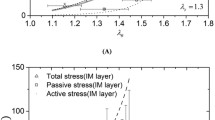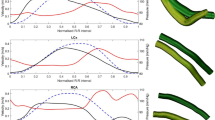Abstract
Identification of an appropriate stress-free reference configuration is critically important in providing a reasonable prediction of the intramural stress distribution when performing biomechanical analyses on arteries. The stress-free state is commonly approximated as a radially cut ring that typically opens into a nearly circular sector, relieving much of the circumferential residual strains that exist in the traction-free configuration. An opening angle is often used to characterize this sector. In this study, we first present experimental results showing significant residual deformations in the longitudinal direction of two commonly studied arteries in the pig: the common carotid artery and the left anterior descending coronary artery. We concluded that a radially cut ring cannot completely describe the stress-free state of the arteries. Instead, we propose the use of a longitudinal opening angle, in conjunction with the traditional circumferential opening angle, to experimentally quantify the stress-free state of an artery. Secondly, we propose a new kinematic model to account for the addition of longitudinal residual strains through employing the longitudinal opening angle and performed a stress analysis. We found that with the inclusion of longitudinal residual strains in the stress analysis, the predicted circumferential stress gradient was decreased by 3-fold and the predicted longitudinal stress gradient was increased by 5.7-fold. Thus, inclusion of longitudinal residual strains has a significant effect on the predicted stress distribution in arteries.











Similar content being viewed by others
References
Chuong, C. J., and Y. C. Fung. On residual stress in arteries. J. Biomech. Eng. 108:189–192, 1986.
Davies, P. F. Flow-mediated endothelial mechanotransduction. Physiol. Rev. 75:519–560, 1995.
Dzau, V. J., and G. H. Gibbons. Vascular remodeling—mechanisms and implications. J. Cardiovasc. Pharmacol. 21:S1–S2, 1993.
Fung, Y.-C., and S. Lui. Change of residual strains in arteries due to hypertrophy caused by aortic constriction. Circ. Res. 65:1340–1349, 1989.
Greenwald, S. E., J. E. Moore, A. I. Rachev, T. P. C. Kane, and J.-J. Meister. Experimental investigation of the distribution of residual stress in the artery wall. J. Biomech. Eng. 119:438–444, 1997.
Han, H. C., and D. N. Ku. Contractile responses in arteries subjected to hypertensive pressure in seven-day organ culture. Ann. Biomed. Eng. 29:467–475, 2001.
Holzapfel, G. A., G. Sommer, M. Auger, P. Regitnig, and R. W. Ogden. Layer-specific 3D residual deformations of human aortas with non-atherosclerotic intimal thickening. Ann. Biomed. Eng. 35(4):530–545, 2007.
Humphrey, J. D. Cardiovascular Solid Mechanics: Cells, Tissues, and Organs. New York: Springer-Verlag, 2001.
Rachev, A. I., and S. E. Greenwald. Residual strains in conduit arteries. J. Biomech. 36:661–670, 2003.
Taber, L. A., and J. D. Humphrey. Stress-modulated growth, residual stress, and vascular heterogeneity. J. Biomech. Eng. 123:528–535, 2001.
Takamizawa, K., and K. Hayashi. Strain energy density function and uniform strain hypothesis for arterial mechanics. J. Biomech. 20:7–17, 1987.
Vaishnav, R. N., and J. Vossoughi. Residual stress and strain in aortic segments. J. Biomech. 20:235–239, 1987.
Vossoughi, J. Longitudinal residual strains in arteries. In: Proceedings of the 11th Southern Biomedical Engineering Conference, Memphis, TN, 1992.
Zaucha, M. T., J. Raykin, W. Wan, R. Gauvin, F. A. Auger, L. Germain, T. E. Michaels, and R. L. Gleason. A novel cylindrical biaxial computer-controlled bioreactor and biomechanical testing device for vascular tissue engineering. Tissue Eng. A 15:3331–3340, 2009.
Acknowledgments
This research was supported by the National Institute of Health Grant number R21-HL085822. The authors would like to thank Dr. Alexander Rachev for his thoughtful discussions and insightful comments.
Author information
Authors and Affiliations
Corresponding author
Additional information
Associate Editor Scott I. Simon oversaw the review of this article.
Rights and permissions
About this article
Cite this article
Wang, R., Gleason, R.L. A Mechanical Analysis of Conduit Arteries Accounting for Longitudinal Residual Strains. Ann Biomed Eng 38, 1377–1387 (2010). https://doi.org/10.1007/s10439-010-9916-6
Received:
Accepted:
Published:
Issue Date:
DOI: https://doi.org/10.1007/s10439-010-9916-6




